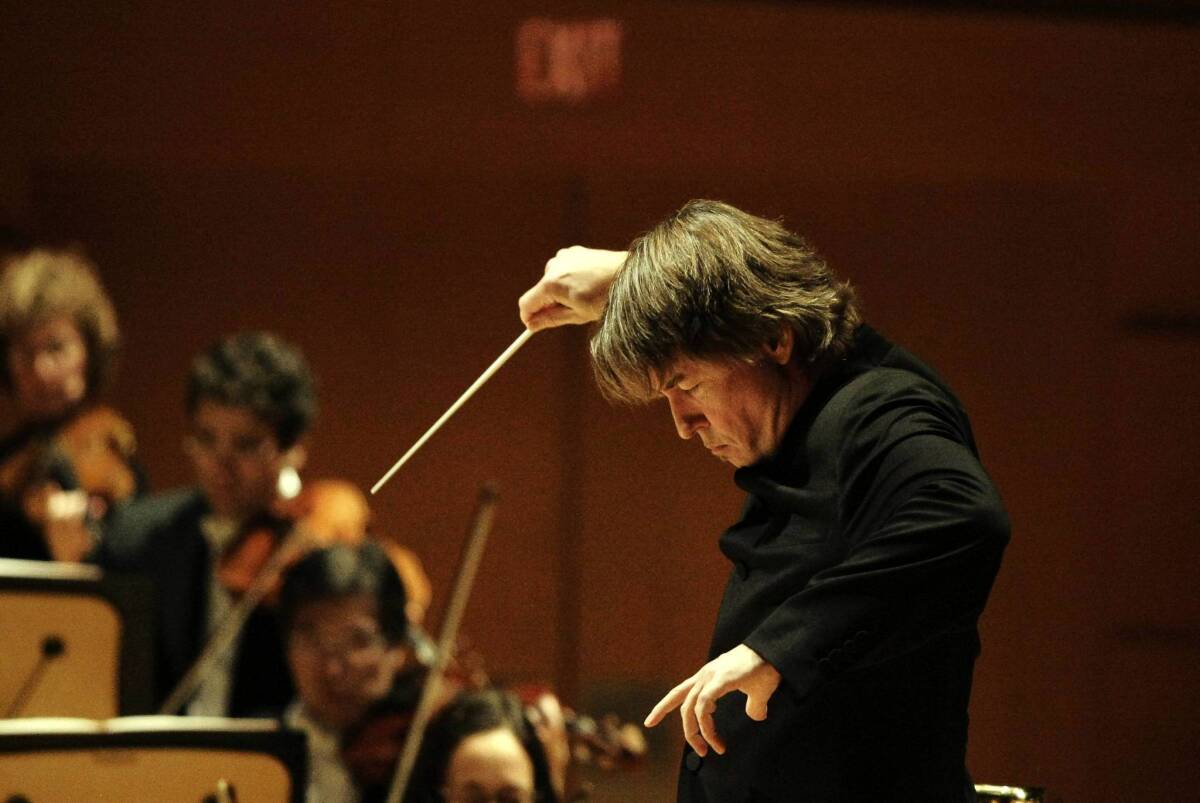Review: Esa-Pekka Salonen conducts L.A. Phil in ‘Nyx,’ more

- Share via
In the more than three years since Esa-Pekka Salonen conducted his last concert as music director of the Los Angeles Philharmonic, he has not managed to write very much music. Even so, Salonen’s recognition as a composer has grown.
One of his farewells to L.A. was the premiere of his Violin Concerto, which went on to win a prestigious Grawemeyer Award. His only major new work has been “Nyx.” It had its premiere in Paris last year as the culmination of a Radio France Salonen festival. “Nyx” reached the West Coast last weekend to begin the second of Salonen’s annual two weeks with his old band, of which he is now conductor laureate, in Walt Disney Concert Hall.
The program was peculiar. In the first half, Schumann’s potboiler Piano Concerto — with the young French pianist David Fray making his Disney debut — followed “Nyx.” After intermission, a refined 1975 song cycle by the Polish composer Witold Lutoslawski featured American baritone Gerard Finley. Finally, the pot boiled over with Tchaikovsky’s “Francesca da Rimini.”
FOR THE RECORD:
Los Angeles Philharmonic: A review of the Los Angeles Philharmonic in the Dec. 10 Calendar section misspelled the first name of baritone Gerald Finley as Gerard. —
PHOTOS: Arts & culture covered by Times photographers
Night and her mysteries had something to do with all of it. In Greek mythology, the nebulous Nyx represents the nocturnal essence. She cannot be observed for portraiture; put a light on her and she vanishes. Salonen seeks her sense.
From the live Radio France online streaming of the premiere, “Nyx” appeared to have set off fireworks in the French skies. Some in the German press have hailed the score a masterpiece. The Brits have been cooler, bemoaning Salonen’s not straying off the middle of the stylistic road. His 17 years in L.A. are blamed for him putting youthful experimentation behind him.
Still, I cannot imagine that anyone had really heard “Nyx,” despite the many times Salonen has conducted it. The fact is, a piece by Salonen is not finished until it has been played by the L.A. Phil in the 3-D Disney acoustic.
At Saturday night’s splendid performance, what mattered most was the sheer sound that Salonen got from the orchestra. The first thing heard was a quiet low G, held in the violins, harp and muted trumpet, as if coming from under the stage. Four horns undulated as if from afar. Nebulous Nyxian melodies took shape, as the strings rose and the winds fell. A pulse started. A solo clarinet introduced one of Salonen’s typically decorated themes that meanders with purpose.
Whether he consciously knows it or not, the composer clearly wrote the fancifully sinuous clarinet solos that help give “Nyx” her inscrutability for the L.A. Phil’s fluid principal clarinetist Michele Zukovsky, who has been in the orchestra since Salonen made his guest conducting debut here in 1984.
There are, in “Nyx,” any number of Salonen traits. The big orchestra climaxes vibrated all of Disney. I heard in the dappled instrumental colors a return to a slightly more European feeling in the composer’s work. He has certainly not lost interest in Ravel, but there is also a Mahlerian kind of night music at work when grotesque details peek through the thick but transparent textures.
The ending is, perhaps, pat — a quick, quiet run up the scale in the violins and harp. But day trips in with a lisp of light.
PHOTOS: Arts & culture covered by Times photographers
The nocturnal context in Schumann’s concerto comes from the composer’s split personality between daylight doer and nighttime dreamer. Fray, who made an intriguing Hollywood Bowl debut with the orchestra in 2010, seemed just fine with schizophrenia.
Fray, who has sterling tone, dreamed over dreamy stuff and puffed his figurative chest for bravura. He made many lavish midperformance lunges for his hanky, which he kept inside the piano. That was impressive. Musically, Salonen satisfyingly kept him from going over the deep end.
The reserved Lutoslawski kept himself from going astray in “Les Espaces du Sommeil” (Realms of Sleep). Salonen recorded this score with the L.A. Phil as long ago as 1985 (the baritone was John Shirley-Quirk). Here the songs acted as the conclusion of a small Lutoslawski centennial festival that the orchestra has undertaken during Salonen’s visit.
The night connection was, of course, obvious. In the text, the French surrealist poet Robert Desnos deliciously and ominously (and sometimes you can’t tell which is which) alludes to everything that slips through our perceptions when the eyelids are shut. Lutoslawski’s music is just as there and not there. Finley made every hallucinatory word matter. Salonen emphasized a heightened sense of reality.
The splashy Tchaikovsky symphonic poem from Dante concerns illicit love and murder. Salonen let the drama speak for itself. He avoided Tchaikovskian sentiment in favor of instrumental sediment, particularly the howling night of Nature as channeled through a great orchestra. Hammer strokes at the end obliterated everything. Maybe that is why he let Nyx off with that little disappearing act.
MORE
INTERACTIVE: Christopher Hawthorne’s On the Boulevards
TIMELINE: John Cage’s Los Angeles
PHOTOS: Arts and culture in pictures
More to Read
The biggest entertainment stories
Get our big stories about Hollywood, film, television, music, arts, culture and more right in your inbox as soon as they publish.
You may occasionally receive promotional content from the Los Angeles Times.











